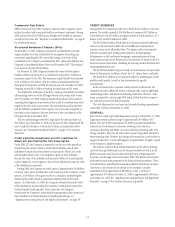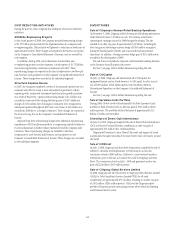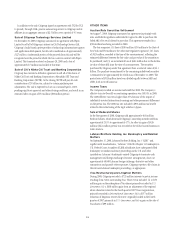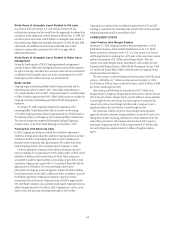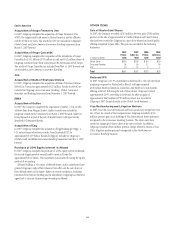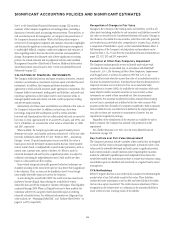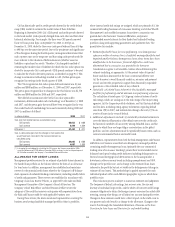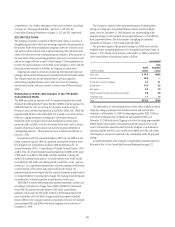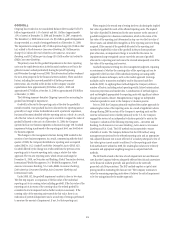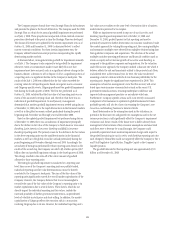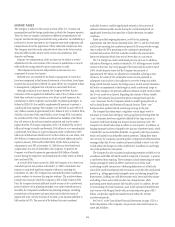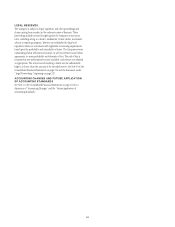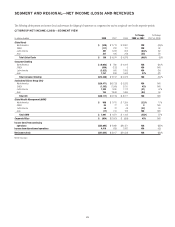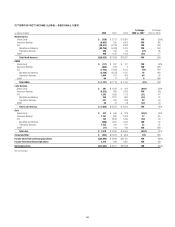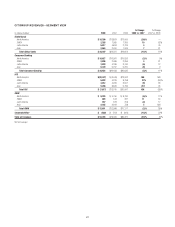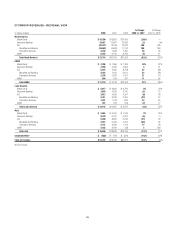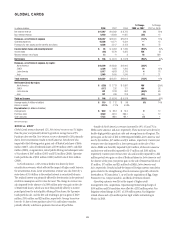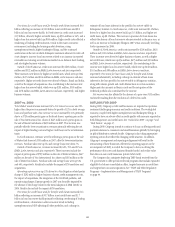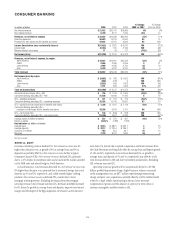Citibank 2008 Annual Report Download - page 27
Download and view the complete annual report
Please find page 27 of the 2008 Citibank annual report below. You can navigate through the pages in the report by either clicking on the pages listed below, or by using the keyword search tool below to find specific information within the annual report.GOODWILL
Citigroup has recorded on its Consolidated Balance Sheet Goodwill of $27.1
billion (approximately 1.4% of assets) and $41.1 billion (approximately
1.9% of assets) at December 31, 2008 and December 31, 2007, respectively.
The December 31, 2008 balance is net of a $9.6 billion goodwill impairment
charge recorded as a result of testing performed as of December 31, 2008.
The impairment is composed of $5.1 billion pretax charge ($4.5 billion after
tax) related to North America Consumer Banking, $4.3 billion pretax
charge ($4.1 billion after tax) related to Latin America Consumer
Banking, and $0.2 billion pre-tax charge ($0.1 billion after tax) related to
EMEA Consumer Banking.
The primary cause for the goodwill impairment in the above reporting
units was the rapid deterioration in the financial markets as well as in the
global economic outlook particularly during the period beginning
mid-November through year end 2008. This deterioration further weakened
the near-term prospects for the financial services industry. These and other
factors, including the increased possibility of further government
intervention, also resulted in the decline in the Company’s market
capitalization from approximately $90 billion at July 1, 2008 and
approximately $74 billion at October 31, 2008 to approximately $36 billion
at December 31, 2008.
The following summary describes Citigroup’s process for accounting for
goodwill and testing for impairment.
Goodwill is allocated to the reporting units at the date the goodwill is
initially recorded. Once goodwill has been allocated to the reporting units, it
generally no longer retains its identification with a particular acquisition,
but instead becomes identified with the reporting unit as a whole. As a result,
all of the fair value of each reporting unit is available to support the value of
goodwill allocated to the unit. As of December 31, 2008, the Company
operated in four core business segments as discussed on page 138. Goodwill
impairment testing is performed at the reporting unit level, one level below
the business segment.
The changes in the management structure during 2008 resulted in the
creation of new business segments. As a result, commencing with the third
quarter of 2008, the Company identified new reporting units as required
under SFAS No. 142, Goodwill and Other Intangible Assets (SFAS 142).
Goodwill affected by the change was reallocated from the previous seven
reporting units to ten new reporting units, using a relative fair value
approach. The ten new reporting units, which remain unchanged at
December 31, 2008, are Securities and Banking, Global Transaction Services,
International Wealth Management, N.A. Wealth Management, North
America Consumer Banking, N.A. Cards, EMEA Consumer Banking,
Latin America Consumer Banking,Asia Consumer Banking and
International Cards.
Under SFAS 142, the goodwill impairment analysis is done in two steps.
The first step requires a comparison of the fair value of the individual
reporting unit to its carrying value including goodwill. If the fair value of the
reporting unit is in excess of the carrying value, the related goodwill is
considered not to be impaired and no further analysis is necessary. If the
carrying value of the reporting unit exceeds the fair value, there is an
indication of potential impairment and a second step of testing is performed
to measure the amount of impairment, if any, for that reporting unit.
When required, the second step of testing involves calculating the implied
fair value of goodwill for each of the affected reporting units. The implied
fair value of goodwill is determined in the same manner as the amount of
goodwill recognized in a business combination, which is the excess of the
fair value of the reporting unit determined in step one over the fair value of
the net assets and identifiable intangibles as if the reporting unit were being
acquired. If the amount of the goodwill allocated to the reporting unit
exceeds the implied fair value of the goodwill in the pro forma purchase
price allocation, an impairment charge is recorded for the excess. An
impairment charge recognized cannot exceed the amount of goodwill
allocated to a reporting unit and cannot be reversed subsequently even if the
fair value of the reporting unit recovers.
Goodwill impairment testing involves management judgment, requiring
an assessment of whether the carrying value of the reporting unit can be
supported by the fair value of the individual reporting unit using widely
accepted valuation techniques, such as the market approach (earnings
multiples and/or transaction multiples) and/or discounted cash flow
methods (DCF). In applying these methodologies the Company utilizes a
number of factors, including actual operating results, future business plans,
economic projections and market data. A combination of methodologies is
used and weighted appropriately for reporting units with significant adverse
changes in business climate. Management may engage an independent
valuation specialist to assist in the Company’s valuation process.
Prior to 2008, the Company primarily employed the market approach for
estimating fair value of the reporting units. As a result of significant adverse
changes during 2008 in certain of the Company’s reporting units and the
increase in financial sector volatility primarily in the U.S., the Company
engaged the services of an independent valuation specialist to assist in the
Company’s valuation of the following reporting units—Securities and
Banking, North America Consumer Banking,Latin America Consumer
Banking and N.A. Cards. The DCF method was incorporated to ensure
reliability of results. The Company believes that the DCF method, using
management projections for the selected reporting units and an appropriate
risk-adjusted discount rate is most reflective of a market participant’s view of
fair values given current market conditions. For the reporting units where
both methods were utilized in 2008, the resulting fair values were relatively
consistent and appropriate weighting was given to outputs from both
methods.
The DCF method used at the time of each impairment test used discount
rates that the Company believes adequately reflected the risk and uncertainty
in the financial markets generally and specifically in the internally
generated cash flow projections. The DCF method employs a capital asset
pricing model in estimating the discount rate. The Company continues to
value the remaining reporting units where it believes the risk of impairment
to be low using primarily the market approach.
21


